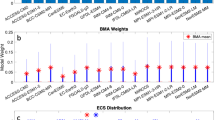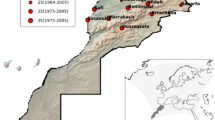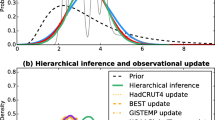Abstract
This paper deals with different responses from various Atmosphere-Ocean Global Climate Models (AOGCMs) at the regional scale. What can be the best use of AOGCMs for assessing the climate change in a particular region? The question is complicated by the consideration of intra-year month-to-month variability of a particular climate variable such as precipitation or temperature in a specific region. A maximum entropy method (MEM), which combines limited information with empirical perspectives, is applied to assessing the probability-weighted multimodel ensemble average of a climate variable at the region scale. The method is compared to and coupled with other two methods: the root mean square error minimization method and the simple multimodel ensemble average method. A mechanism is developed to handle a comprehensive range of model uncertainties and to identify the best combination of AOGCMs based on a balance of two rules: depending equally on all models versus giving higher priority to models more strongly verified by the historical observation. As a case study, the method is applied to a central US region to compute the probability-based average changes in monthly precipitation and temperature projected for 2055, based on outputs from a set of AOGCMs. Using the AOGCM data prepared by international climate change study groups and local climate observation data, one can apply the MEM to precipitation or temperature for a particular region to generate an annual cycle, which includes the effects from both global climate change and local intra-year climate variability.
Similar content being viewed by others
References
AchutaRao et al (2004) An appraisal of coupled climate model simulations. In: Bader D (ed) Livermore, California
Brekke L, Miller N, Bashford K, Quinn N, Dracup J (2004) Climate change impacts uncertainty for water resources in the San Joaquin river basin, California. J Am Water Resour Assoc 40(1):149–164
Brooke A, Kendrick D, Meeraus D (1998) GAMS: a user’s guide. Scientific
Changnon S, Hollinger S (2003) Problems in estimating impacts of future climate change on midwestern corn yields. Clim Change 58:109–118
Dessai S, Lu X, Hulme M (2003) Development of a simple probabilistic climate scenario generator for impact and adaptation assessments. Geophys Res Abstr 5(12547)
De Fraiture C (2003) The use of entropy optimization principles in parameter estimation: applications to global water and food modeling. PhD dissertation submitted to the Faculty of the Graduate School of the University of Colorado, Department of Civil Environmental Architectural Engineering, Colorado, p 165
Giorgi F, Mearns L (2002) Calculation of average, uncertainty range, and reliability of regional climate changes from AOGCM simulations via the “Reliability Ensemble Averaging” (REA) method. J Climate 15(10):1141–1158
Giorgi F, Mearns L (2003) Probability of regional climate change based on the Reliability Ensemble Averaging (REA) method. Geophys Res Lett 30(12):1629
Golan A, Judge G, Miller D (1996) Maximum entropy econometrics: robust estimation with limited data. Wiley, New York
Hu Q, Buyanovsky G (2003) Climate effects on corn yield in Missouri. 42:1626–1635
IPCC-ES (2000) Emissions scenarios. Special report of the intergovernmental panel on climate change. Cambridge University Press, Cambridge, England
Jaynes E (1978) Where do we stand on maximum entropy? In: Levine RD, Tribus M (eds) The maximum entropy formalism. MIT, Cambridge, USA, pp 15–118
Jones RN (2000) Analyzing the risk of climate change using an irrigation demand model. Clim Res 14:89–100
Kharin V, Zwiers F (2002) Climate predictions with multimodel ensembles. J Climate 15(7):793–799
Krishnamurti T, Kishtawal C, LaRow T, Bachiochi D, Zhang Z, Williford E, Gadgil S, Surendran S (1999) Improved weather and seasonal climate forecasts from multimodel ensemble. Science 285:1548–1550
Krishnamurti T, Kishtawal C, Zhang Z, LaRow T, Bachiochi D, Williford E (2000) Multimodel ensemble forecasts for weather and seasonal climate. J Climate 13:4196–4216
Kunkel K, Liang X (2005) CMIP simulations of the climate in the central United States. J Climate 18:1016–1031
Manning et al (2004) Describing scientific uncertainties in climate change to support analysis of risk and of options. Workshop report, May 2004, Boulder, Colorado
Miller N, Bashford KE, Strem E (2003) Potential impacts of climate change on California hydrology. J Am Water Resour Assoc 39(4):771–784
New M, Hulme M (2000) Representing uncertainty in climate change scenarios: a Monte-Carlo approach. Integrated Assessment 1:203–213
New M, Hulme M, Jones P (2000) Representing twentieth-century space-time climate variability. Part II. Development of 1901–1996 monthly grids of terrestrial surface climate. J Climate 13:2217–2238
Phillips D, Lee J, Dodson R (1996) Sensitivity of the US corn belt to climate change and elevated CO2. I. Corn and soybean yields. Agric Syst 52:481–502
Pukelsheim F (1994) The three sigma rule. Am Stat 48:88–91
Räisänen J, Palmer T (2001) A probability and decision-model analysis of a multimodel ensemble of climate change simulations. J Climate 14(15):3212–3226
Rosenberg N, Brown R, Izaurralde R, Thomson A (2003) Integrated assessment of Hadley centre (HadCM2) climate change projections on agricultural productivity and irrigation water supply in the conterminous United States I. Climate change scenarios and impacts on irrigation water supply simulated with the HUMUS model. Agric For Meteorol 117:73–96
Shannon C (1948) A mathematical theory of communications, I–IV. Bell Systems Technical Journal 27:379–443 and 623–656
Tan G, Shibasaki R (2003) Global estimation of crop productivity and the impacts of global warming by GIS and EPIC integration. Ecol Model 168:357–370
Vysochanskii DF, Petunin YI (1980) Justification of the 3σ rule for unimodal distributions. Theory Probab Math Stat 21:25–36
Author information
Authors and Affiliations
Corresponding author
Rights and permissions
About this article
Cite this article
Laurent, R., Cai, X. A maximum entropy method for combining AOGCMs for regional intra-year climate change assessment. Climatic Change 82, 411–435 (2007). https://doi.org/10.1007/s10584-006-9197-0
Received:
Accepted:
Published:
Issue Date:
DOI: https://doi.org/10.1007/s10584-006-9197-0




